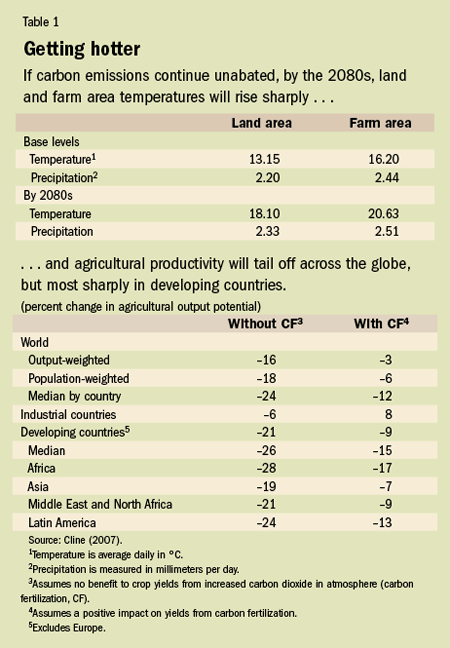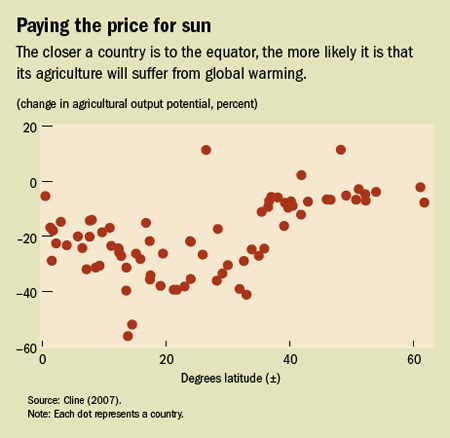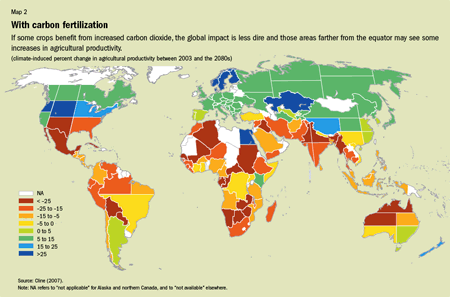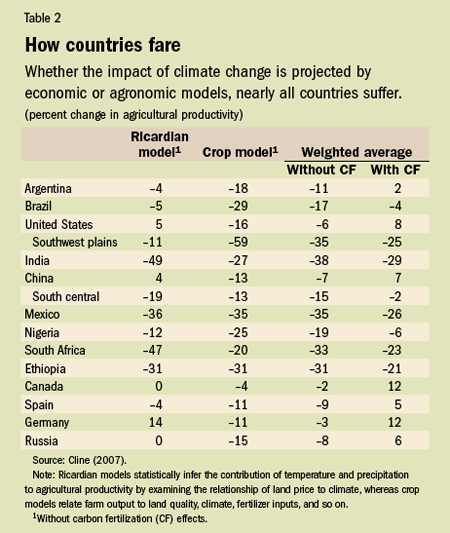March 2008, Volume 45, Number 1 ![]()
Global Warming and Agriculture
William R. Cline
If steps are not taken to curb carbon emissions, agricultural productivity could fall dramatically, especially in developing countries
John Steinbeck's The Grapes of Wrath provides a verbal mural depicting America's experience in the Dust Bowl of the 1930s, with its migration of "Okies" from ruined farmlands in Oklahoma and Texas to a not-so-promised land in California. This historical experience and perhaps the present-day drought of biblical proportions in Australia should alert international policymakers to the risks to world agriculture of a hotter and drier world by late this century as a consequence of unarrested global warming.
In the long list of potential problems from global warming, the risks to world agriculture stand out as among the most important. Yet there has been a tendency in the climate economics literature in recent years to downplay this risk, and even to argue that a couple of degrees Celsius warming might benefit world agriculture. But such studies typically have too short a time horizon (generally out to about 2050). They also focus on overall temperature change (which includes oceans), rather than on the changes that will occur over land (which warms more easily and quickly than water)—and specifically agricultural land.
It has been widely recognized that developing countries in general stand to lose more from the effects of global warming on agriculture than do industrial countries. Most developing countries have less capacity to adapt than do their wealthier neighbors. Most are in warmer parts of the globe, where temperatures are already close to or beyond thresholds at which further warming will reduce rather than increase agricultural output. And agriculture is a larger share of developing economies than of industrial economies. But it has been difficult to estimate just how much individual countries are likely to be affected.
For that reason, this study (Cline, 2007) was undertaken both to get a better long-term fix on overall world effects under current policies (the so-called baseline or business-as-usual scenario) and to understand the likely impact on individual countries and regions. The time frame stretched out to the average for 2070–99, what is called the "2080s." Climate model projections are available on a comparable basis for this period, which is far enough in the future to allow sizable warming and potential damage to materialize but close enough to the present to elicit public concern. The study, which is explored in this article, suggests that there is good reason not to downplay the risks to agriculture from global warming.
How climate affects agriculture
Climate change can affect agriculture in a variety of ways. Beyond a certain range of temperatures, warming tends to reduce yields because crops speed through their development, producing less grain in the process. And higher temperatures also interfere with the ability of plants to get and use moisture. Evaporation from the soil accelerates when temperatures rise and plants increase transpiration—that is, lose more moisture from their leaves. The combined effect is called "evapotranspiration." Because global warming is likely to increase rainfall, the net impact of higher temperatures on water availability is a race between higher evapotranspiration and higher precipitation. Typically, that race is won by higher evapotranspiration.
But a key culprit in climate change—carbon emissions—can also help agriculture by enhancing photosynthesis in many important, so-called C3, crops (such as wheat, rice, and soybeans). The science, however, is far from certain on the benefits of carbon fertilization. But we do know that this phenomenon does not much help C4 crops (such as sugar-cane and maize), which account for about one-fourth of all crops by value.
Crunching the numbers
To estimate the country-specific impact of global warming on agriculture if carbon emissions continue to grow unabated, the study combined two sets of existing models—one from climate science and the other from agronomy and economics. Six leading climate models provided estimates of future changes in temperature and precipitation at a typical detail of about 2,000 land-based areas, or grid cells. These changes were added to information on present climate (about 22,000 land cells) and then averaged to obtain a consensus climate projection at a detail of about 4,000 land cells. These estimates were fed into crop impact models from agronomy and economics to produce the yield-impact estimates, which were then averaged up to the level of countries and regions.
The consensus of the six models shows that a doubling of atmospheric carbon concentration will produce an eventual overall warming of 3.3°C. This is close to the UN Intergovernmental Panel on Climate Change (IPCC) estimate of what is called "climate sensitivity," or the amount of long-term global warming to be expected from a doubling of carbon dioxide in the atmosphere above preindustrial levels —an indication that the models are producing mainstream forecasts.
To develop these estimates, the baseline emissions projections from the most widely used scenario in the IPCC's Third Assessment Review in 2001 were fed into the climate models. Currently, annual fossil-fuel emissions amount to about 7 billion tons of carbon. Under the IPCC's business-as-usual estimate, they would rise to about 16 billion by 2050 and 29 billion by 2100, partly because of a greater use of coal. The corresponding atmospheric concentrations of carbon dioxide would reach 735 parts per million (ppm) by 2085, in contrast to the preindustrial level of 280 ppm and today's level of 380 ppm.
The study divides the world into 116 countries and regions. By the 2080s, the six climate models predict an average surface temperature increase of nearly 5°C weighting by land area and about 4.4°C weighting by farm area (see Table 1, top panel). This is higher than a global mean warming of 3°C, because land areas warm more than the oceans. Precipitation also rises, but only by about 3 percent.

The climate change projections are then applied to the agricultural impact models to develop two sets of assessments of the effect of climate change on agricultural productivity. One set, the "crop models," relates farm output to land quality, climate, fertilizer inputs, and so forth (Rosenzweig and Iglesias, 2006). The other, "Ricardian models," statistically infers the contribution of temperature and precipitation to agricultural productivity by examining the relationship of land price to climate—agricultural productivity improves as temperatures go from cold to warm, then deteriorates going from warm to hot (Mendelsohn and Schlesinger, 1999). Models relating county- or farm-level data on land values or net revenue to such influences as soil quality as well as temperature and rainfall are now available for Canada, the United States, India, and many countries in Africa and Latin America. Both sets of models tend to produce similar results. The study combined them to create a consensus estimate of crop yields both under conditions in which there is no benefit from increased carbon dioxide on crop yields and under assumptions that result in positive effects from carbon fertilization.
The impact on crop yields
The results give little support to the optimists. Globally, the overall impact of baseline global warming by the 2080s is a reduction in agricultural productivity (output per hectare) of 16 percent without carbon fertilization, and a reduction of 3 percent should carbon fertilization benefits actually materialize—when results are weighted by output (see Table 1, bottom panel). The losses are greater when weighted by population or country.
The sharp concentration of losses is in the developing countries. Whereas the industrial countries experience outcomes ranging from 6 percent losses without carbon fertilization to 8 percent gains with it, developing country regions suffer losses of about 25 percent without carbon fertilization and 10–15 percent if carbon fertilization is included. For developing countries, the median loss would be 15–26 percent, and the output-weighted average loss, 9–21 percent. Losses could reach devastating levels in some of the poorest countries (greater than 50 percent in Senegal and Sudan).
Damage will generally be greater in countries located closer to the equator (see chart), where temperatures already tend to be close to crop tolerance levels. Country elevation also matters. For example, because of higher elevation and lower average temperatures, Uganda faces smaller losses (17 percent without carbon fertilization) than Burkina Faso (24 percent) even though the latter is situated about 10 degrees farther north of the equator. Whereas the major losses are concentrated in the lower latitudes, the gains, where they occur, are toward the higher latitudes. In the absence of any boost from carbon fertilization, the most severely affected countries are in Africa, Latin America, and south Asia, although most of the world registers a decline in agricultural productivity (see Map 1). Will carbon fertilization benefits help much? The answer appears to be yes and no. There are still very adverse outcomes for countries in Africa, Latin America, and south Asia—although some individual countries and subregions would fare much better (see Map 2).



On a more detailed country and regional breakdown, the study shows the following (see Table 2):

In South America, there are potentially sizable losses in Argentina and Brazil if the carbon fertilization effect does not materialize, and moderate losses in Brazil even with carbon fertilization—although Argentina would be better off.
In North America, there is a tremendous variation from the north to the south. For the United States, the overall outcome would average from a 6 percent overall decline without carbon fertilization to an 8 percent increase with it. But this average masks large potential losses in the southeast and in the southwest plains, where the weighted average of the Ricardian and crop models shows losses ranging from 25 percent if there is a carbon fertilization benefit to 35 percent without the benefit. Canada, like the United States, shows small losses without carbon fertilization and moderate gains with it. And Mexico shows losses of 25–35 percent.
In Africa there are large losses. Nigeria's losses range from 6 to 19 percent, and South Africa's and Ethiopia's losses are much larger.
In Europe, Germany has small losses without carbon fertilization and moderate gains with it. For Spain, the results are somewhat less favorable, once again reflecting latitudinal location. For Russia, without carbon fertilization, productivity declines by 8 percent; with it, Russia shows gains of 6 percent.
In Asia, the contrasting picture for the two largest and most dynamic developing countries is stark. India produces perhaps the most disturbing single set of results, with losses ranging from about 30 to 40 percent. China would have a more moderate range, from a 7 percent loss to a 7 percent gain. Its results resemble those of the United States: in both countries, the average effects are relatively neutral, but there are sizable losses in the southern regions. The contrast with India is strictly consistent with India's location closer to the equator. Both China and the United States have a latitude center of about 38° north, whereas India's latitude center is about 22° north.
A technological rescue?
There are those who argue that rapid technological change will raise agricultural yields so much by late this century that any reduction caused by global warming would easily be more than offset. But technological change is a false panacea for several reasons.
First, the green revolution has already slowed. Calculations based on UN Food and Agricultural Organization data show that grain yields, which rose at an annual rate of 2.7 percent in the 1960s and 1970s, have risen at only a 1.6 percent annual rate in the past quarter century. Although rising agricultural prices might provide incentives that would slow or reverse this decline, such a response is not assured.
Second, even if there is no further slowdown, there is likely to be a close race between rising food demand and rising output. Global food demand is expected to approximately triple by the 2080s because of higher world population and higher incomes. It also seems quite likely that a sizable share of land will be shifted to the production of biomass for ethanol fuel. As a result, there is a rather precarious balance between supply and demand, which would be seriously worsened by a major adverse shock from global warming.
The stakes are large
This study's estimates underscore the importance of coordinated international action to limit carbon dioxide emissions and avert warming and damage that will likely otherwise occur, not only in agriculture but also from sea level rise and increased intensity of hurricanes, among other things.
Moreover, it is likely that actual global losses will be worse than those portrayed here. Neither crop nor Ricardian models can account for the influence of what are likely to be increases in extreme weather, such as droughts and floods, and insect pests. Nor do the estimates take account of agricultural losses associated with rising sea levels, a major consideration in countries such as Bangladesh and Egypt. More fundamentally, by taking a snapshot of the 2080s, the estimates do not capture the much greater damage that could be expected from the still more severe global warming that would occur by the 22nd century if no steps are taken to curb carbon emissions.
The developing countries are most at risk, so it is strongly in their own interest that they participate actively in international abatement programs. China already produces larger carbon dioxide emissions than the European Union and will soon surpass those of the United States. Global emissions from developing countries (including from deforestation) are already equal to those from industrial countries, and are growing faster.
It is striking that the two largest developing countries, India and China, seem to have potentially conflicting interests in their approach to international abatement efforts. With broadly neutral or even positive effects on its agriculture, China could be less interested in international efforts to restrain emissions than India, which faces major potential losses if there is no change in global emissions policies. But even in China, some key subregions are at risk.
It is fortunate that at the December 2007 UN Climate Conference in Bali, Indonesia, nations agreed to pursue negotiations toward a new international agreement to succeed the Kyoto Protocol by 2009. Of the two leading industrial countries that had refused to sign the Kyoto accord, Australia has recently changed governments and signed on, and, in the United States, the leading presidential candidates of both parties have called for relatively aggressive reductions in U.S. emissions of carbon dioxide. If leading developing nations, such as Brazil, China, and India, also become more disposed to take steps to reduce emissions, the new negotiations could set the stage for meaningful international abatement measures in the post-Kyoto period.
Publicar un comentario